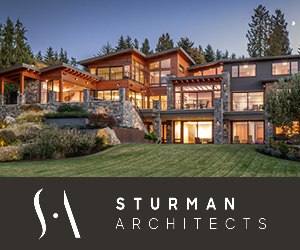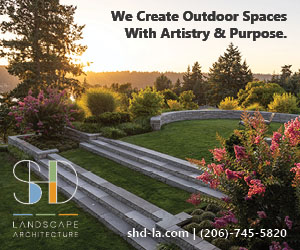Cambium | www.cambiumlandscape.com
Can you trace your interest in landscape architecture back to a particular influence?
From the moment that I learned Landscape Architecture existed, I knew it was what I wanted to do. It’s the perfect blend of art and science that creates functional and ever-changing works of art.
You help homeowners find a personal expression through their garden, how do you approach or decide on the overall “feel” of a landscape?
The first step is to listen critically to what the client loves, what they don’t like, what the needs of their family are, and if they have specific problems with their property. From there, I look to the site-specific details of the property as well as the architecture of the home to create places of substance, perfectly tailored to the client.
What are key things to remember when designing for Pacific Northwest climate?
So many of us here are drawn to the outdoors. When spring arrives, we take our sun-starved selves outside and drink in the natural beauty that surrounds us. Microclimates become an important consideration. Creating a garden that has the perfect spot to be in – enjoying a sunny spot for your morning coffee, soaking up the last rays of an early spring afternoon, or enjoying a shady spot out of the summer sun. At Cambium Inc., we work to create a variety of places throughout any landscape, to optimize the outdoor experience in any season or weather.
You strive to create landscapes that are beautiful, functional, and enhance the quality of life. Tell us more about this.
Our homes are personal expressions of ourselves. They tell visitors a lot about us, and no two people will have quite the same needs or aesthetic preferences. Every garden we create is as unique as each client. I strive to create places that people can feel are special. This feeling is created by a deep connection to nature and place and is reinforced by such factors as scale, function, flow, seasonality, consistency of detailing, and connection to the client’s home architecture and lifestyle.
Designing outdoor living spaces can include working with hardscape, water and fire features and a variety of plantings. What is important to keep in mind?
We talk about using the right plant in the right place, but plants also help to create the character of the space – rough and bombastic textures playing off of each other lends a much different feel than a garden populated with fine-textured plants and only white blossoms. The hardscape of a garden should respond to the plantings and the plantings should be influenced by the hardscape. It’s about balance and a reciprocal relativity that yields a landscape worth more than the sum of its parts.
What are some of your favorite public or private gardens?
Having spent some of my formative years growing up in the San Juan Islands, that rugged, magical, native landscape is a constant source of inspiration for me. That said, I draw inspiration from just about everywhere. Whether it’s a small section of a garden in my neighborhood, or a grand Renaissance estate such as the Villa De Este in Italy, or the pattern the wind makes on the waves of an isolated bay. If we’re paying attention, there’s inspiration everywhere. It’s a matter of really looking closely at the details.
Three words that most appropriately sum up your approach to landscape design are…
Beautiful, functional, complimentary
Outside of design what interests you?
Art, travel, and just about any outdoor activity; from hiking and gardening, to surfing, snowboarding or sailing our small boat across the Salish Sea and beyond.






